A sci-fi drama about conversion therapy.
I mixed this unlikely brew in “A Cleansing,” a film I wrote and directed at NJ Film School this season. The film cuts between two loosely connected scenes which, together, display the experience of hating part of oneself, of seeking relinquishment from one’s true being: a deeply internal conflict shared by many in the LGBTQ+ community.
“A Cleansing” was a story I cared strongly about telling, and one I felt needed more coverage. As of June 2019, it is legal for licensed professionals to attempt conversion therapy on minors in 32 states (Movement Advancement Project). This baseless procedure can be harmful, especially in the most vulnerable era of one’s life.
Please read that again. It’s important.
Okay, now let’s go behind the scenes.
Returning to my Roots
You know, I forgot for a while that I like sci-fi.
Back in the day, I wrote scripts about time travel, about alternative dimensions, about a kid getting trapped in his TV. But at some point, by a sway of interest or perhaps a bias toward more “serious” genres, I stepped away from sci-fi and began writing dramas about important issues.
It took “A Cleansing” for me to realize the two are not mutually exclusive.
So I returned to sci-fi with new eyes, with a new urgency to tell stories that impact people. I hope that “A Cleansing” does just that.
Two Intertwined Scenes
“A Cleansing” cuts between two scenes. Let’s talk about them.
The Procedure
Hello, Aliza, and welcome to Tabula Rasa.
Aliza lies in a procedure room. A tranquil voice informs her about the Cleansing procedure and guides her through preliminaries.
The procedure will now begin. Please refrain from moving or blinking.
Aliza feels pulsing tension, begins to shake, panics, sobs, and laughs. She is dragged through a swirling range of artificial emotions as the real ones are vacuumed out.
In the end, Aliza is left void of all emotions. We hold a little too long on this emotionless shell before rolling credits.
The Cleansing procedure is now complete. Thank you for choosing Tabula Rasa.
The Bedroom
Hey, Aliza. What you said today made me really nervous.
Aliza sits at her bedroom desk. As the pleading voicemail of Aurora plays, Aliza takes out a memory box and sifts through it. She pulls out a polaroid of the two of them and cuts it. (Sorry, Instax.)
I love you. Don’t forget that.
She looks through a group of photos from her childhood. A picture of her parents from when she was younger, from when times felt simpler. She rips it.
You can choose love, Aliza. What’s stopping you?
Next, Aliza finds the real kicker: a picture of Aurora kissing her on the cheek. It’s in a car, isolated from the rest of the world, honest, beautiful, love. She pulls out a lighter and burns it. (I swear I have nothing against you, Instax.)
Stop fearing yourself. Stop hating yourself. I love you, every single part of you. You should, too.
But Aliza can’t feel this way about herself, no matter how much she desires to.
She extinguishes the polaroid in a glass of water.
The Bridge
I love the ambiguity of this story structure. These scenes could be tied in three different ways:
- The bedroom scene occurs on the night before the procedure. Aliza is destroying her memory box because she knows distancing herself from the ones she loves is the only way she’ll be able to commit to the procedure.
- Only the bedroom scene really occurs: Aliza is destroying her memory box to distance herself from those she loves and move on without Aurora in her life. The procedure scene is a metaphorical representation of this.
- Only the procedure scene really occurs: Aliza is undergoing the Cleansing procedure to rid herself of all emotions. The bedroom scene is a metaphorical representation of the emotions being cut, ripped, and burned from within her.
I personally wrote “A Cleansing” with the first in mind, but I believe the arrangement and distinct styles of the scenes allow for various interpretations. If you had a different view on the film altogether, share your perspective with me in the comment section.
My Obsession with Names
I have an obsession. It’s a bit of a problem.
Every name I choose for a character has some sort of meaning, even if it’s not so easy to identify.
For our main character, I wanted a name with “A” and “Z” to represent a full spectrum of emotions. After much a-searchin’, I landed on Aliza.
I pictured the girlfriend as an emergence of certain covered feelings for Aliza, a dawn of sorts. You can connect the dots from here.
Tabula Rasa means “clean slate” in Latin. This is essentially what the corporation turns its costumers into.
The title is clear satire of the notion that homosexuality is an illness of which one can be cleansed. However, one choice you may find interesting is that of “A Cleansing” over “The Cleansing” or simply “Cleansing.” The word “A” has the power to make a situation seem either lonely or quite the opposite, as it indicates a lack of uniqueness. Here, it implies that this is not a conflict of Aliza alone—hundreds of thousands of American adolescents have been subjected to conversion therapy, according to a report by the Williams Institute at UCLA. Aliza is one of many.
Reading and Writing with Actors
Everyone on a production is writing a script. Long after the screenplay has been drafted and finalized, a gaffer rewrites it with their lighting choices, a cinematographer with camera angles and movements, an editor with cuts, a composer with the score.
And, of course, an actor with their performance.
I worked with two of my actresses, Gabriella Diaz and Emma Bertram, outside of film school to develop their characters in ways far beyond the two-dimensional screen.
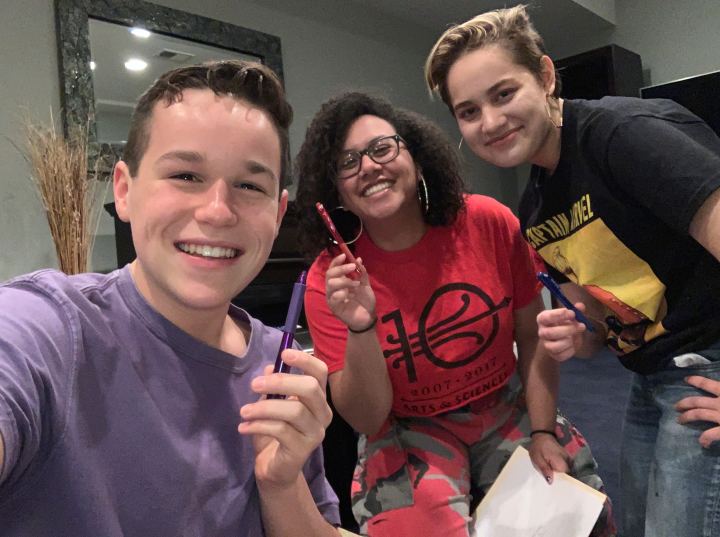
We read the script and talked about who their characters were, their relationship, when they figured out their sexuality, how they fell in love, how they felt about it, how Aliza’s parents discovered it, and what moments culminated in Aliza’s decision to cleanse herself of all emotions.
I wrote all this information down and gave a typed copy to the actresses at our pre-production film school meeting:

Working with the actresses in this intimate setting without any crew members allowed us to discuss personal experiences to find the core of the characters. Even memories that may seem unrelated to the screenplay can shape a performance by providing a reference.
Having fully stretched out and molded the characters, we took polaroid pictures so we would have them for the pre-production session at film school.
We took a bunch so we’d have plenty to cut and burn during the shoot.
After the meeting, Gabriella continued her exploration of Aliza’s past by writing down specific memories attached to each item in the memory box.

Even though the audience never learns any of these details, they could inform Gabriella’s performance by giving known motives to her actions. Why does she pick up that item?
Week 1: Pre-Production
An important role of the director is to share their vision with the cast and crew so that everyone adheres to the same style, tone, and purpose (with suggestions welcome, of course). This ensures consistency in the filmmaking process: we will not have the gaffer lighting for a suspenseful drama while the editor scores for an adventure flick.
I prepared a guide for my cast and crew, which we talked through to clear any confusion:

This wasn’t final—we made decisions all the way from pre-production through post—but it functioned well as a base and a jumping-off-point.
We spent the next hour running—nay, walking—through the two scenes. We blocked out Gabriella’s handling of the trinkets, refined Emma’s vocal delivery, and worked on Gabriella’s performance during the procedure. By the end, we had a fairly firm grasp on what would go down one week later.
Finally, we laid out a shot list.
For the bedroom scene, the two main shots were Aliza Medium (a straight-on shot of Gabriella) and OTS Photos (a high shot of the photos over Gabriella’s shoulder).

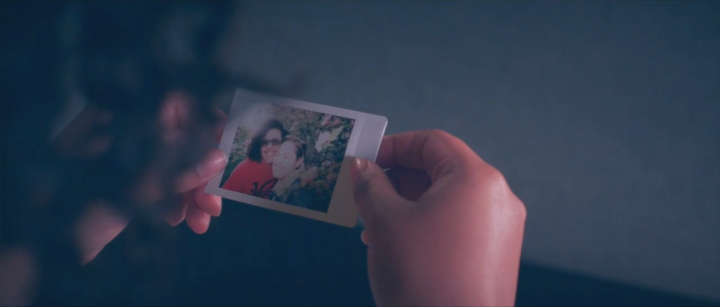
Once we had our main coverage planned, we thought up auxiliary shots. Reverse Medium provides us with an alternate, more isolated picture of Aliza in her room; the dolly-in makes for a nice opening shot of the scene.

Items Close serves to show the items Aliza uses, so it doesn’t feel like she grabs them from Mary Poppins’ bag; it also provides context for the voicemail (the phone) and foreshadows the climax (the lighter).

Aliza Close is a low shot of Aliza just behind the photo in her hand; it functions as a closer, more intense shot of Aliza for the igniting of the polaroid. Glass Close racks focus to the glass of water as Aliza places the partially burnt polaroid into it.

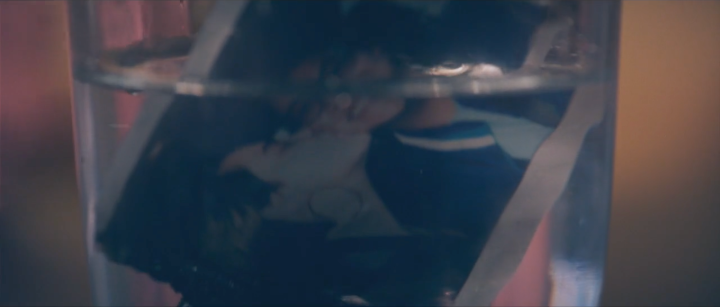
The final shot in the bedroom is one we cannot see in the final cut: Aurora Voiceover.
For the procedure room scene, we planned two shots: Aliza Wide and Aliza Medium. They are practically the same shot, the latter a tighter shot of Aliza. In the editing room, I only ended up using one.

We considered a jib up at the end of the scene, but the motion tracking on the green screen would have been very difficult, and the movement didn’t fit my vision of a rigid procedure room scene.
We went over the scene to ensure that Logan Calder (the cinematographer), John Li (the camera assistant), and I had a common understanding of the shots.
I also took some more polaroids of Gabriella and Emma, this time in my car. We took four of Emma kissing Gabriella on the cheek so we’d be able to burn a few without worrying about continuity.
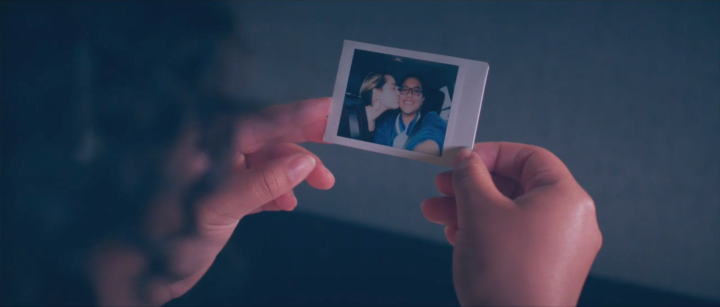
Five Below: Production Design on a Budget
“A Cleansing” would not be what it is without all the people who helped me along the way: namely the cast and crew, Chris Messineo, and my dad. However, I have to give the most credit to my new best friend: Five Below.
I spent hours drifting through the store, looking for cheap items to dress the set. I eventually settled on three props:
- A poster of a unicorn splattered with dark paint. It looks damaged, almost cracked. I felt that the imagery of this colorful thing being darkened fit the theme of the story.
- A Dream sign. I slashed and sawed it with a steak knife to extend the broken imagery and almost imply that, at some point before the film, Aliza sliced it out of anger.
- Small, black clothespins connected by twine. This structure is intended to hold polaroids, but they are bare in the film. This arrangement builds on the desolate feel and implies that polaroids used to hang along the wall but have been pulled down at some prior point.
The three items totaled to $11.
Wednesday Prepping
The day before the shoot, my mom got some pictures printed for me at our local Rite Aid. (Thanks, mom!) However, the scanner didn’t work, so I still had to copy the picture of the parents.
That night, Gabriella and I FaceTimed to review some things.
First, we went over the procedure scene, since we didn’t have much time in class to do so.
Next, we discussed outfits. We decided that she should style her hair naturally in the bedroom scene, then gel it back for the procedure room scene. This represents the unnatural restraining of her natural self due to the Cleansing procedure. I wanted her to wear a colorful shirt in the bedroom scene, and we decided on a black tank top for the procedure scene. This ended up changing during production, but we’ll get to that.
In fact, we’re there right now.
Week 2: Production
It was 4:15. I stopped at Walgreens on my way to film school to get the picture of my parents copied.
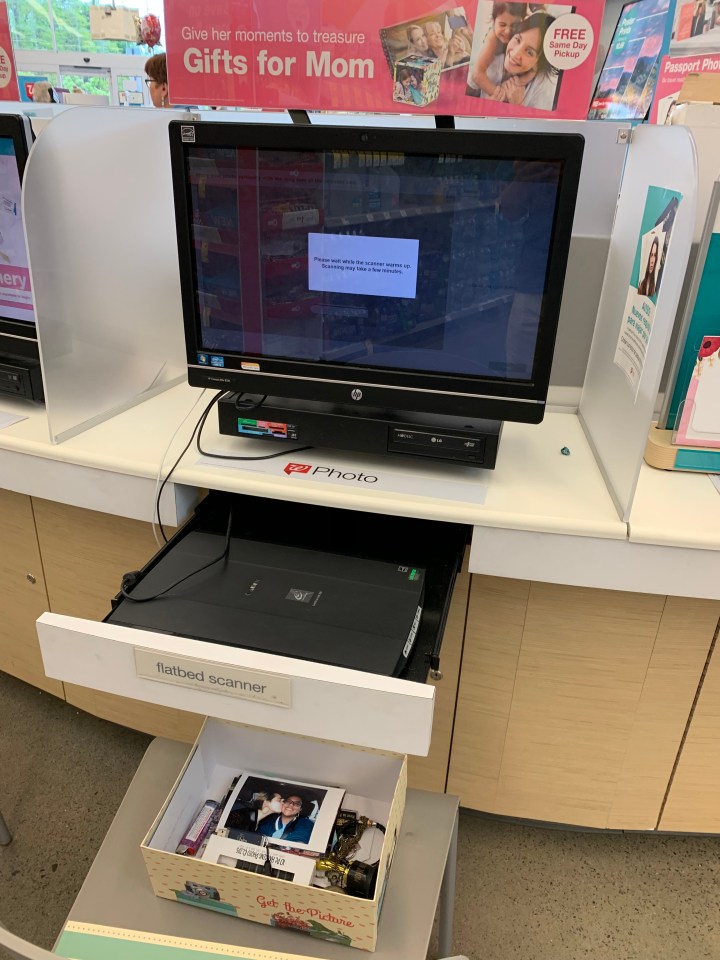
But there was a problem: the wait time. My copies wouldn’t be ready for pickup until 4:45, and the shoot was scheduled to begin at 5. I decided to abandon the images and have Gabriella rip the original photo. Then, I would pick up the copies after film school.
I arrived at NJ Film School 30 minutes early to dress the set. I placed the unicorn poster above the bed and strung the twine around the Dream sign above the desk. Gabriella helped me transform the classroom into a bedroom by placing books and a water bottle.


I wanted a desk lamp to be the main source of light for this scene so that it would feel like a private nighttime scene. The desk lamp acted as a practical light, a light that appears on screen as a prop. We also used a few other lights so that Gabriella would be fully lit.
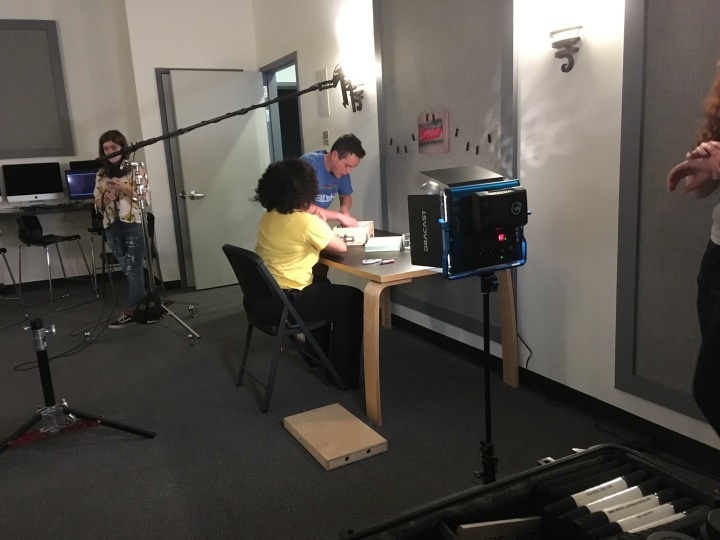
We began with the bedroom scene. We rehearsed a few times then got right into it. We realized that it was difficult for Gabriella to lift the memory box from the floor, so we placed it on an apple box with an edge extending over.
You know a shoot went smoothly when even the dolly shot rolls without a hitch. Hats off to Logan and John.

Gabriella’s performance was fantastic. She made riveting choices that elevated certain moments and made them distinct from others, such as rubbing her legs after ripping the photo of her parents.
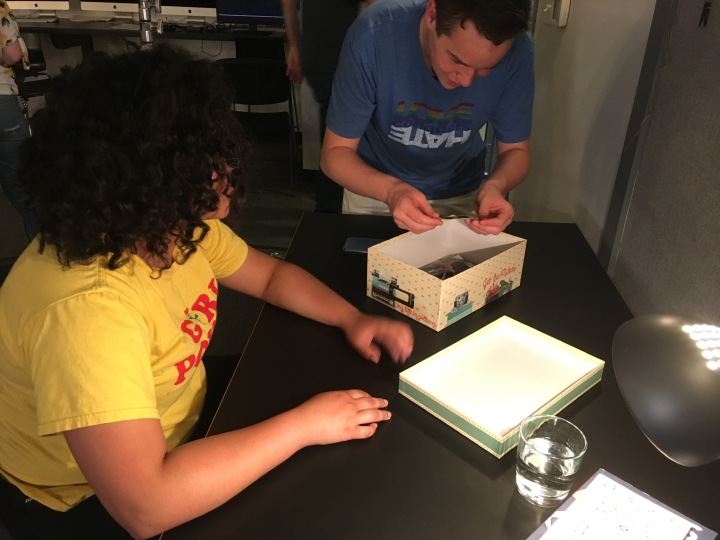
Before we left the bedroom set, we recorded Emma’s voiceover.

Emma too masterfully became her character. I wore the headphones during this recording, and I felt such powerful and precise emotions flooding into my ears. She really captured the frustration, the desperation, the love I had laid out in the screenplay.
When we were about to film the procedure room scene, Chris showed us a possible costume from the place next door.
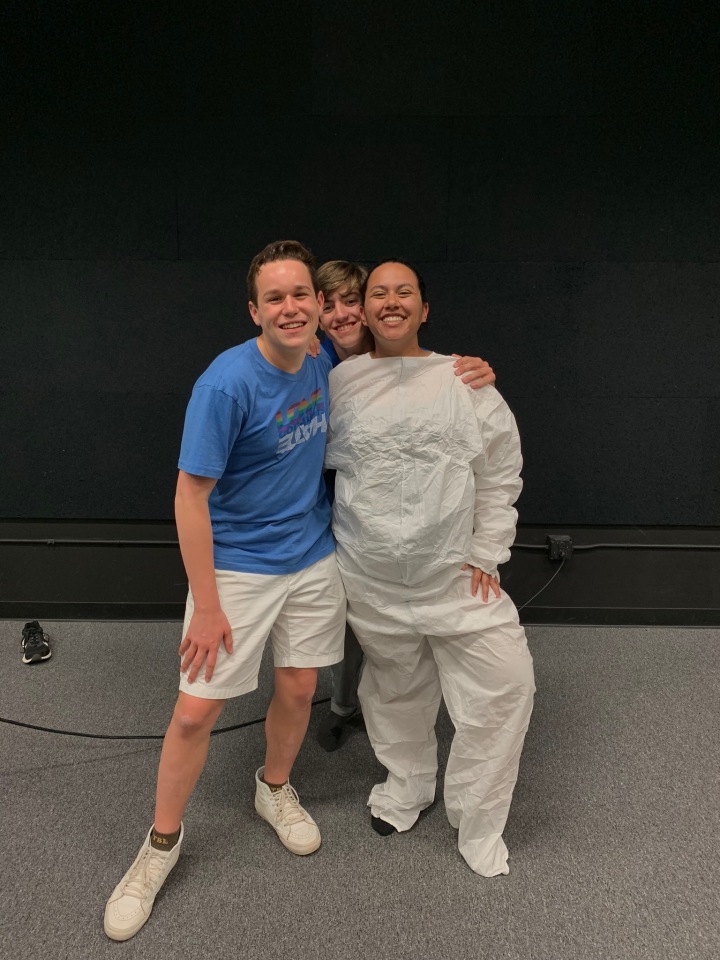
It was great—it perfectly fit the restraining and disinfected look I was going for in this scene. Thanks, Chris!
Gabriella tied her hair back (with the help of her costar Emma) and we were onto the final shot.

We used a jib to record Gabriella from above. As per Chris’ brilliant suggestion, Gabriella lay on apple boxes, hidden behind her head and body, so she would appear to be floating. This added to the futuristic feel of the scene. I placed t-squares under Gabriella’s head so she wouldn’t awkwardly lean back.
Once again, I have to applaud Gabriella. She took a very uncomfortable scene to act out and pushed herself through it with full caliber. You go, girl.
I later realized that we had forgotten to record the voicemail recording,
You have thirteen new messages.
but we figured that we could record it within the following weeks when we were set up for another shoot.
Week 3: Post-Production
One of my main issues as I dig deeper into filmmaking is that I love so many facets of it. I adore the creative control of directing, the stylistic responsibility of cinematography, the structured spiritual liberation of acting (which you’ll read all about later in a shorter blog post about “The Neighbor“), and the purposeful sequencing of the edit. You can’t do everything, so it’ll be a struggle for me to figure out which I wish to focus in on.
I appreciate editing the films I direct because I’m both a micro- and macro-oriented filmmaker, and editing is an opportunity to paint a second coat over my work. It is vital to cut at the right moment, to show a relevant reaction, to counterpose scenes to form a shared meaning. In “A Cleansing,” this was especially important as the two scenes bounce off of one another to mold the complete message of the film.
Luckily for me and the film, Gabriella and John joined me at the editing desk, and their inspired ideas did, too.
We tried to meld the two scenes together in interesting ways. When one asks a question, the other answers. When one features Aliza experiencing something, it shares with the other.
Aurora: I don’t know, I’m just worried about you.
Tabula Rasa: There is no need to worry. Our Cleansing procedure is FDA-approved and currently holds a 100% success rate.
There were times when we drew out smooth bridges, such as the hyperventilation of one Aliza flowing into the other’s, and times when we drew a thick line. John’s idea to change scenes at an inhale, for instance, succeeds in holding the audience’s discomfort: without a resolution, the breath feels trapped.
That’s the power of editing.
And you can harness that power a lot in the little details. For example, I aligned Aurora’s first line so that it ends just as Aliza’s box hits the desk, synthesizing a moment of silence, reflection, and hesitation not largely clear in the raw footage.
Editing is also about personal aesthetic tastes. I loved how the Reverse Medium captured Gabriella throwing the ripped pieces of her parents picture. Sometimes there needn’t be a particular reason: if it feels right, it probably is. Now, that isn’t to say that you should throw purpose to the floor and base your choices solely on airy whims. However, there is something to say about a filmmaker’s instincts. I only hope that as I mature and my senses grow in stronger, my instincts, informed by experience, will become louder and more natural.
We realized in the edit that the initial voicemail line was unnecessary. It’s fairly obvious that Aurora’s voice is on a voicemail, and (in my opinion) the scene would feel clunkier with the line.
For the procedure room, I only used Aliza Medium, because the natural moment never came to cut to Aliza Wide, and the former felt more restricted. Chris did most of the special effects work, but I found effects I thought would set the right feel. For example, we added a drop shadow to give Aliza the appearance of floating, and Chris used the blue streaks I found to cover up the jump cuts in the edit. I combined various sound effects we already had on the computer, including various sci-fi sounds and beeping in morse code, to build a progressive kicking-into-gear noise for the Cleansing procedure.
With some post-pro magic, we finalized the film, and it was ready for the world (or at least our families and friends) to see.
The Screening
Alright, let’s screen this thing.
This film, like almost all, is a product of collaboration. “A Cleansing” was Frankenstein’s monster: we all sowed our own interpretations of the characters together in order to craft a well-rounded sculpture. I’ve said it before and I’ll say it more: I would build a million monsters with these people.

Last Week etc.
I have a heck of a lot to write about, don’t I?
On Friday, the first day of summer vacation, I got back into “In Memoriam” by shooting a large chunk of the scenes in one day. That film is the longest I’ve ever attempted, so it’ll be a while before you all can see the final cut.
Yesterday, I shot and edited a film I’m really excited about, titled “Gemini.” The short film stars Nick Casey and features a score by Beth Polito. [Edit: Beth and I ended up co-writing the score!] It’ll drop on YouTube in mid-July, so stay tuned. [Another edit: it was August. Wow, this film took some wild turns. I should write a blog post about it.]
Next week, I’m off to the Poconos to be a camera assistant on a feature-length indie titled Generation Wrecks. Production for this 90s teen comedy, directed by Kevin T. Morales, will take place from June 29th to July 14th. Bridget McGarry, whom I met at NJ Film School, got me involved in this project. I’m so excited and thankful for the opportunity to work on this set!
My next blog post will be about my recent experiences with theatre on film: filming and editing the recording of my high school’s production of High School Musical, and witnessing Kiss Me Kate be live-recorded and -edited by the Theatre on Film and Tape Archive.
Cut to Broadway.







Another fantastic recap!
I especially love this:
“Everyone on a production is writing a script. Long after the screenplay has been drafted and finalized, a gaffer rewrites it with their lighting choices, a cinematographer with camera angles and movements, an editor with cuts, a composer with the score.”
LikeLiked by 1 person
Thanks! 😊
LikeLike
Austin, Mom and I are so proud of you. We know this topic, conversions therapy, is very important to you. Scream from the rooftops and let the world know just how harmful this type of therapy is to young children. Don’t stop fighting until it is abolished for good. Then move on to the next injustice you feel the need to right. Use the power of your films to change the world for the better! Thanks to everyone who helped him make it happen.
LikeLiked by 1 person
Love you, dad 🥰
LikeLike